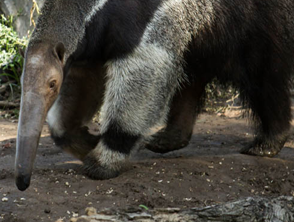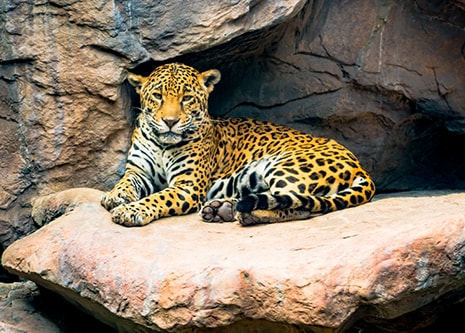
- VisitSupport Happy HollowDONATE TODAYExploreSupport Happy HollowDONATE TODAYLearnSupport Happy HollowDONATE TODAYSupport
-
Today's Hours: 10:00 am to 5:00 pm
Zoo on the HillGiant anteater

Scientific name: Myrmecophaga tridactyla
Family: Myrmacophagidea
Order: Pilosa
Class: Mammalia
Range: Central and South America
Habitat: Grassland, tropical forest and rainforest
Lifespan: 10 to 14 years in the wild; up to 16 years in captivity; oldest on record was 25 yearsWhat do they look like?
Giant anteaters are large mammals known for their elongated snout and long, bushy tail. They have distinctively patterned brownish-black, gray and white fur. This species is predominantly terrestrial (typically on the ground) unlike its other anteater relatives which are primarily arboreal (typically up in the trees). Males of this species are typically larger than females. Giant Anteaters can reach lengths of up to seven feet and weigh between 60 to 140 pounds, making them the largest anteater species. Their tube-like muzzle holds no teeth, and instead has a two-foot-long tongue covered in sticky saliva!How do they behave?
Giant anteaters are generally solitary (live alone), and will only socialize with other anteaters to breed and raise young. They walk on their front knuckles to keep their long, pointed foreclaws up away from the ground. This unique way of walking makes giant anteaters relatively slow animals. The giant anteater has three main predators: jaguars, mountain lions, and humans. To protect itself, a giant anteater may rear up on its hind legs and lash out at a predator with its sharp foreclaws. They travel between open grassy areas to forage and they use forested areas for protection while they rest. Giant anteaters have poor eyesight, and rely on their excellent sense of smell to seek out insects. They tear into the ground to reach their prey, and can end up eating 30,000 insects a day. They can be either diurnal (active during the day) or nocturnal (active at night).What do they eat?
Giant anteaters are insectivores, feeding primarily on ants and termites, and occasionally honey bees and beetles. If available, they may also lick at fallen fruit. At Happy Hollow, they are fed a pelleted insectivore diet, oranges, avocado and mealworms.How are they born?
Giant anteaters mate year-round, and females have a gestation period of 190 days. They give birth to only one pup at a time, and its eyes are closed until it is about a week old. The mother carries her pup on her back while traveling, stopping to nurse and groom. The pup is fully weaned and independent by 10 months, but they don’t reach sexual maturity until they are 2.5 to 4 years old.Conservation
The conservation status of giant anteaters is listed as Vulnerable by the International Union for Conservation of Nature due to the local extinctions (when a population of animals in a certain area completely dies out). Their populations have declined or become locally extinct as a result of more frequent vehicle collisions, habitat loss, wildfires, and hunting for use in illegal trade or as pests. One group working towards giant anteater conservation is called the Iberá Project, which is dedicated to the conservation of the Iberá region of Argentina, an important habitat for this species. The Iberá Project works to protect giant anteaters through captive breeding and reintroduction, research, and spreading awareness. To participate in anteater conservation, purchase coffee that is shade grown, and produce that is grown locally. These products do not require the destruction of rainforest land to grow crops and they will help your local economy.
Zoo in the Hollow
Follow the crooked bamboo pathway down into the hollow and visit with some of the most amazing animals in the world. Where else in San José can you get up close to a stunning jaguar, lemur, meerkat or American alligator? Happy Hollow is dedicated to helping save species and preserve wildlife for future generations by participating in Species Survival Plan programs through the Association of Zoos and Aquariums.
See Animals
Education Ambassadors
From camps and classes to scout badges and sleepovers, Happy Hollow education programs have something for everyone! The zoo education program offers a broad range of hands-on, engaging programs and public presentations featuring education ambassador animals. These encounters are designed to connect you to wildlife and the conservation of their habitats around the world.
See AnimalsVisit Us Today
Plan an unforgettable experience at San Jose’s family-friendly park and zoo.
Learn More